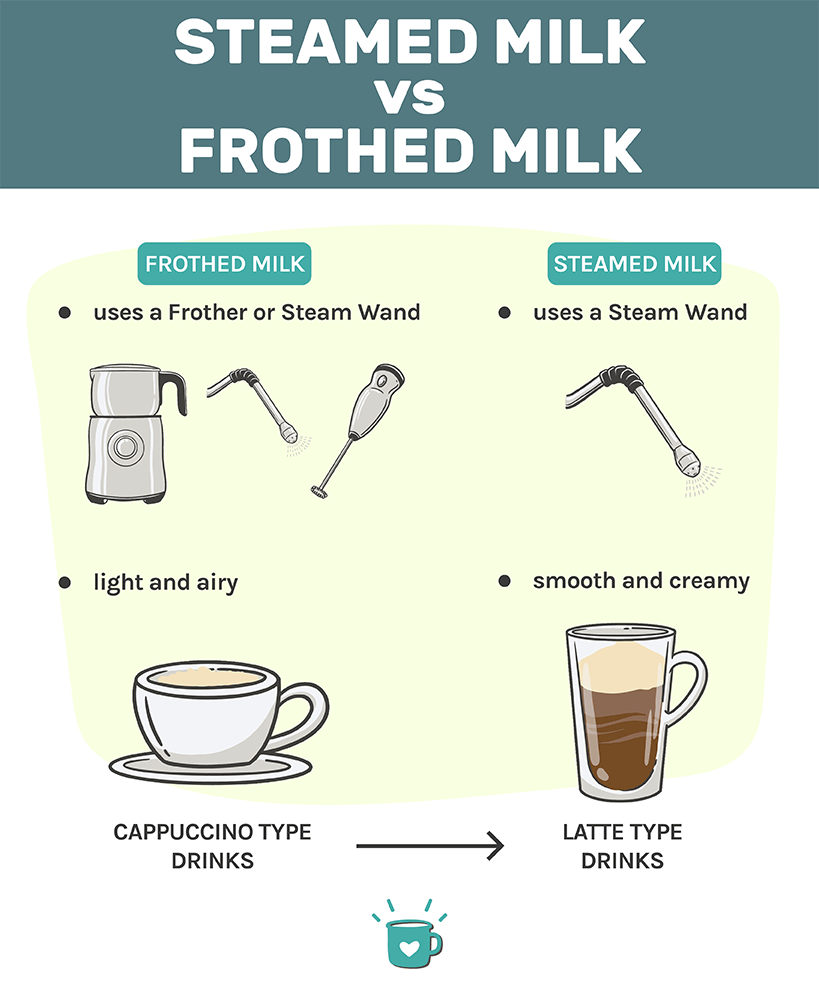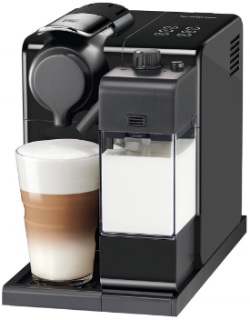Are you a coffee lover who enjoys indulging in a variety of coffee-based drinks? If so, you may have come across terms like “steam wand” and “milk frother” when exploring the features of coffee machines. But do you know the difference between these two components? While both help create that perfect creamy texture in your favorite coffee beverages, they serve different purposes. In a nutshell, a steam wand is typically found in espresso machines and is used to heat and steam milk, while a milk frother is a separate standalone device that is solely used for frothing milk. So, let’s dive deeper into understanding the nuances between these two essential tools for coffee aficionados!

Steam Wand
Definition
A steam wand is a component of a coffee machine that is specifically designed for steaming and foaming milk. It consists of a metal pipe with small holes at the end, through which steam is released. The steam wand is connected to the boiler in the coffee machine, which heats the water and generates steam.
Function
The primary function of a steam wand is to create steam that can be used to heat and froth milk. When the steam wand is activated, steam is released at a high pressure, which creates a swirling motion in the milk when it is submerged. This swirling motion helps to incorporate air into the milk, creating a velvety foam and heating the milk to the desired temperature.
Design and Operation
Steam wands are typically made of stainless steel and are attached to the side of the coffee machine. They are operated by a knob or lever, which controls the flow of steam. The user can adjust the position and angle of the steam wand to achieve the desired frothing or heating result. The steam wand also often has a small rubber sleeve, known as a steam tip, which helps to create a narrow and controlled stream of steam.
Types of Steam Wand
There are two main types of steam wands: traditional steam wands and automatic steam wands.
Traditional steam wands require the user to manually control the steaming process by adjusting the position and angle of the wand and monitoring the temperature and consistency of the milk throughout the process. This type of steam wand provides the user with a higher level of control and customization, but it also requires more skill and experience to achieve the desired results consistently.
Automatic steam wands, on the other hand, are equipped with sensors and programmed settings that automatically control the steaming process. These steam wands are designed to create consistent frothing and heating results with little to no user intervention. While they may be more convenient for those who are less experienced or prefer a hands-off approach, they may not offer the same level of customization and control as traditional steam wands.
Milk Frother
Definition
A milk frother is a standalone device that is used to froth and heat milk. It is typically a small, handheld device that consists of a whisk-like attachment and a motor. Milk frothers can be electric or manual, and they are often used in conjunction with a coffee machine that does not have a built-in steam wand.
Function
The main function of a milk frother is to aerate milk and create foam by rapidly whisking it. When the whisk attachment is activated, it creates a vortex in the milk, which incorporates air and creates tiny bubbles. This process results in a creamy foam that can be used for lattes, cappuccinos, and other milk-based beverages.
Design and Operation
Milk frothers come in a variety of designs, but they generally consist of a handle or body that houses the motor and a removable whisk attachment. The whisk attachment is usually made of stainless steel or another durable material and is shaped like a small whisk or beater. Some milk frothers have interchangeable whisk attachments, allowing you to choose between different frothing styles or textures.
To use a milk frother, you simply place the whisk attachment into a container of milk and activate the motor. The whisk will rotate at a high speed, creating a vortex in the milk and incorporating air to produce foam. The frothing process is typically complete within a minute or two, depending on the desired level of foaminess.
Types of Milk Frother
There are two main types of milk frothers: electric milk frothers and manual milk frothers.
Electric milk frothers, as the name suggests, are powered by electricity and feature a motor that rotates the whisk attachment. These frothers are generally more convenient and efficient since the motor does the work for you. Electric milk frothers also tend to produce a more consistent foam, making them a popular choice for those who want a hassle-free frothing experience.
Manual milk frothers, on the other hand, do not require electricity and rely on manual force to whisk the milk. These frothers typically consist of a container with a plunger or pump mechanism that you manually press or pump to agitate the milk. While they may require more effort and time compared to electric frothers, they can still produce a satisfactory foam and are often favored by those who prefer a hands-on approach or want more control over the frothing process.

Differences between Steam Wand and Milk Frother
Purpose
The main difference between a steam wand and a milk frother lies in their purpose. A steam wand is primarily designed for use in coffee machines and is specifically intended for steaming and frothing milk. It is an integral part of the coffee-making process, allowing baristas and coffee enthusiasts to create delicious and visually appealing milk-based beverages.
On the other hand, a milk frother is a separate device that is used independently from a coffee machine. Its primary purpose is to froth and heat milk, making it suitable for individuals who enjoy homemade coffee or prefer the convenience of a standalone frother. While a steam wand is more commonly used in professional settings such as cafes or coffee shops, a milk frother is a popular choice for home use.
Technique
The technique used with a steam wand and a milk frother differs significantly. With a steam wand, the user needs to manually control the position and angle of the wand, as well as monitor the temperature and consistency of the milk throughout the steaming process. Achieving the perfect foam and temperature requires practice and skill, as slight variations in technique can greatly impact the end result.
In contrast, a milk frother operates with a simple whisking or pumping action, which produces foam by incorporating air into the milk. While some electric milk frothers have preset settings, the technique remains relatively straightforward and requires less skill and practice compared to using a steam wand. This simplicity makes milk frothers a popular choice for those who are new to frothing or want a quick and easy frothing solution.
Steam vs Air
One of the key differences between a steam wand and a milk frother is the medium used to froth the milk. A steam wand utilizes steam generated by the coffee machine’s boiler. The high-pressure steam is released through the small holes in the wand, creating a swirling motion that introduces air into the milk and produces a velvety foam.
On the other hand, a milk frother relies on air agitation to create foam. The whisk attachment or pump mechanism churns the milk, creating a vortex that traps air and forms bubbles. This process aerates the milk and produces a froth that can be used for a variety of beverages.
Flexibility
In terms of flexibility, a steam wand typically offers more options and customization compared to a milk frother. With a steam wand, the user has control over the position, angle, and flow of steam, allowing for different frothing styles and textures. This flexibility enables the creation of latte art and accommodates individual preferences for milk-based beverages.
On the other hand, milk frothers generally have a single whisk attachment or pump mechanism, limiting the options for frothing styles and textures. While some electric milk frothers may have preset settings for different foam densities, they lack the versatility and customization options of a steam wand.
Control
Control over the frothing process is another area where steam wands and milk frothers differ. Steam wands provide the user with more control and precision due to their manual operation. The user can adjust the position, angle, and intensity of the steam, as well as monitor the temperature and consistency of the milk throughout the process.
In comparison, milk frothers, especially electric ones, offer less control over the frothing process. While some models may have adjustable settings for foam density or temperature, the level of control is generally more limited. This can be advantageous for those who prefer a consistent and hassle-free frothing experience but may be frustrating for individuals who want more control over the end result.
Ease of Use
When it comes to ease of use, milk frothers generally have the upper hand. They are designed to be user-friendly and require minimal effort and technique. With a milk frother, you simply need to activate the whisk or pump mechanism, and the frothing process begins. This simplicity makes milk frothers suitable for beginners or individuals who prefer a no-fuss frothing experience.
In contrast, using a steam wand requires more skill, practice, and attention. The manual operation and need for technique can make it more challenging and intimidating for beginners. However, with practice, anyone can master the use of a steam wand and achieve consistent frothing results.
Time and Efficiency
In terms of time and efficiency, milk frothers generally offer a quicker frothing process. Electric milk frothers, in particular, can froth and heat milk in a matter of minutes, while manual milk frothers may require slightly more time and effort. This speed and convenience make milk frothers ideal for individuals on the go or those who appreciate a streamlined frothing process.
On the other hand, using a steam wand may take longer, especially for beginners who are still honing their technique. Achieving the desired foam density and temperature can take practice and a bit of trial and error. However, once the user becomes proficient, a steam wand can provide efficient and consistent frothing results.
Versatility
When it comes to versatility, a steam wand offers more options and possibilities compared to a milk frother. With a steam wand, the user can create a wide range of frothing styles and textures, allowing for the customization of milk-based beverages. Additionally, steam wands are often used in professional settings for latte art, making them a popular choice for baristas and coffee enthusiasts who want to showcase their creativity.
While milk frothers can produce a satisfactory foam, they may not offer the same level of versatility as a steam wand. The limited options for frothing styles and textures can be a drawback for individuals who enjoy experimenting with different milk-based beverages.
In conclusion, steam wands and milk frothers are both valuable tools for creating delicious and frothy milk beverages. Each has its own distinct features and benefits, offering different levels of control, technique, and versatility. Whether you prefer the flexibility of a steam wand or the convenience of a milk frother, both options can elevate your coffee experience and ensure the perfect frothy milk every time.

